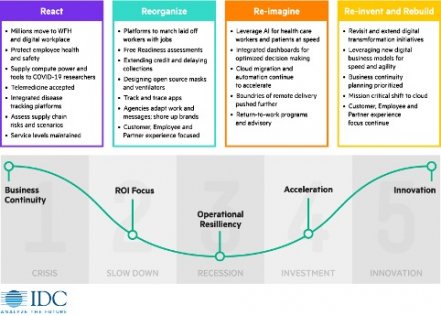In the wake of the coronavirus pandemic, technology will prove pivotal to business recovery as organisations seek to restore revenue.
Global market intelligence firm IDC predicts that businesses recovery will have five clear stages. In a recent interview with ZDNet, IDC President Crawford Del Prete defined the five stages of the pandemic as: crisis, slowdown, recession, investment, and finally recovery.
Del Prete explains that organisational responses will match these phases.
The first phase was all about maintaining business continuity, with organisations transitioning to remote working as governments across the globe announced lockdown measures.

Now organisations are moving out of crisis mode, into focusing on ROI and cost optimisation. With a global recession flattening economies, Del Prete says businesses will now look to “flatten their own organisation’s recessionary curve by leveraging technology”.
All in all, he says, “innovation is the only viable path for enterprise recovery”. One of the key innovations that Hewlett Packard Enterprise (HPE) has seen its customers embracing is a compact hyperconverged infrastructure (HCI) that can be deployed simply and quickly, and that offers a 50% lower cost per remote worker.
PetSure, a leading provider of pet insurance, chose HPE Nimble Storage dHCI to deliver remote veterinary care and enable future growth, and was able to reduce operating costs by 50%, while improving performance times for Virtual Desktop Interface (VDI) workloads 100%, and achieving 50% faster application provisioning.
“We can now provide a superior VDI solution to support changes to our business model and our 400+ employees working remotely”, said Rob Collins, Head of Infrastructure and Service Management at PetSure. “In the past, we were using AWS for our VDI workloads, but the costs were too high for us. With HPE Nimble Storage dHCI, we were able to… improve efficiency by 70 per cent”.
Now, as organisations seek to accelerate innovation and time to market by driving unprecedented resilience, agility, and workload consolidation from IT, all this is within reach, with intelligent, hyperconverged infrastructure. HCI 2.0 is emerging as a central element for data centres globally. HPE’s Thomas Goepel has said that this is because HCI 2.0 enables what technology-powered businesses want and have asked for: built-in intelligence, automation, flexible economic models, enhanced security, and accelerated opportunity to market.
“HCI has gone through a really big transformation in the last few years. When I look at how it originally started, it was literally people looking for a better way of building virtual desktop infrastructure (VDI) solutions. They wanted to combine servers and storage in a single device and make it easier to operate”, Goepel explained.
Now, HCI is becoming a core element in data centres around the world and the use cases have significantly expanded. It may have started with VDI, but HCI is now being used for many other business applications, including critical databases like SAP HANA.
HCI’s rapid growth has been driven by its ease of use—but it also came with limitations, especially when it came to mixed and unpredictable workloads. These are the limitations that HCI 2.0 fixes.
You can read more about how HCI 2.0 can power your business into the future at HPE.com.





